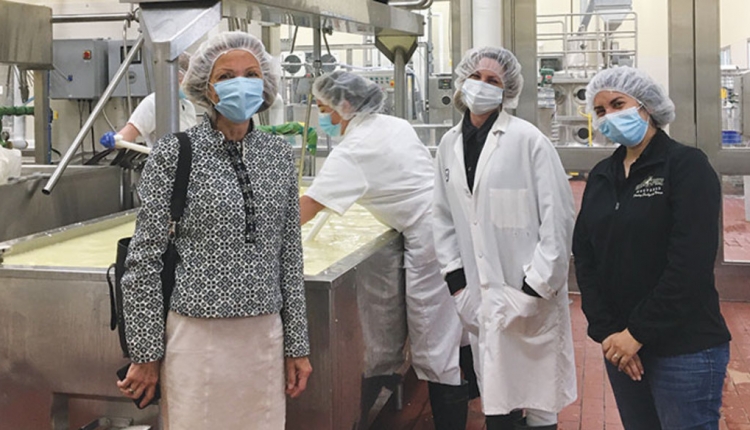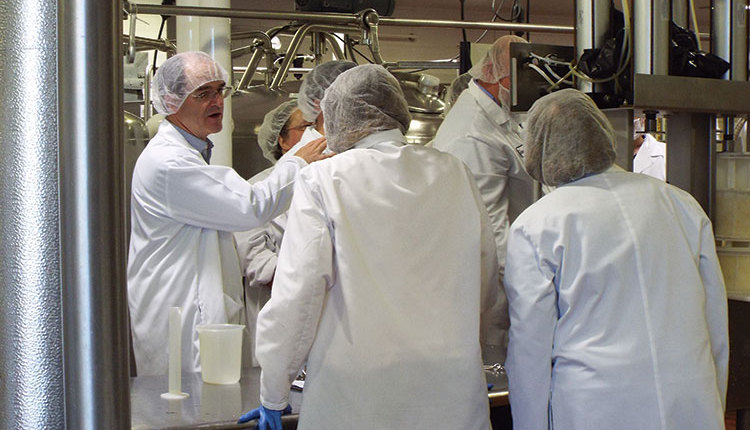The author and her family own and operate a sixth-generation dairy near St. Johns, Mich.

A five-prong approach
The researchers at MDFRC, in collaboration with dairy farmers and dairy product manufacturers, focus on five main areas:
• Analytical tools and testing
• Dairy-based ingredients
• Manufacturing
• Safety
• Value-added products
They evaluate these factors in an attempt to enhance milk sales, technology, and knowledge.
As the center grew, the Agricultural Utilization Research Institute became a sponsor, and MDFRC opened the Institute for Dairy Ingredient Processing at South Dakota State University. This major effort opened the door for commercial-scale and feasibility studies. Currently, MDFRC has over 20 faculty who handle dairy’s most pressing issues. The team has issued several patents, authored over 200 publications, and presented over 500 abstracts at national and international conferences in support of dairy food research.
Jayendra Amamcharla is the interim director of MDFRC. After earning three degrees in his native country of India, he moved on to earn his Ph.D. in agricultural and biosystems engineering from North Dakota State University, and he completed his postdoctoral work at South Dakota State University. He is currently a professor in the department of animal sciences and industry at Kansas State University, and he focuses his research on the development of rapid and nondestructive sensing technologies for dairy products.
Let’s help someone
“There’s no point in doing research if it’s not helping someone,” Amamcharla said. “In these farmer-funded programs, we always need to keep in mind who will benefit from the research.”
MDFRC manages a process to bring problems and solutions together.
“The center plays a big role in connecting farmers, researchers, and processors. We hold a research planning meeting in the spring where we brainstorm project ideas — what project we should fund next, what areas we should be looking at, and where we need to improve. Our ultimate goal is how to increase milk sales,” he said.
In the past, high-priority research areas have included topics like sustainability, ingredient function, and consumer perception. After the meeting, the call for proposals comes out and the researchers prepare 500-word abstracts. To decide which get funding, a representative committee looks at the top three to five proposed projects from each institution. Then each team presents on it, and the consortium votes on which proposals have the greatest potential for success.
Iowa State University professor Stephanie Clark is an associate director at MDFRC, and she has been involved in the process for years.
“I look at the call for proposals and think about what skill set will fit in the call. I decide — can I design a project to address this high-priority issue? I try to be broad and open-minded to the needs of the farmers and industry partners,” she said.
From feed to food
Clark recently worked with distillers grains to see what kind of effects it had on cows, milk, and cheese.
“Being from a farm myself and working with animals now really brings it home and makes it all more tangible to the farmer supporter,” she said. “I’m continually asking — why am I doing this, what is this work for, and how is it important to dairy?”
In the research project “Feeding reduced-fat dried distillers grains with solubles to lactating Holstein dairy cows does not alter milk composition or cause late blowing in cheese,” Clark and her fellow researchers tested the effect of feeding reduced-fat dried distillers grains on milk composition and suitability for the production of baby Swiss cheese. They also studied the effect of this diet on cow lactation performance.
The control variable cows were fed corn, corn silage, and alfalfa hay supplemented with soybean meal. The variable diet was the same base ration but with 20% reduced-fat dried distillers grain with solubles in place of soybeans.
The researchers saw no treatment effect on milk yield, fat production, milkfat percentage, milk protein production, lactose percentage, milk total solids, or somatic cell count. They did find that dry matter intake was elevated in those cows fed dried distillers grains, which suggested a reduction in feed efficiency. They did not find significant differences in cheese, however.
The results showed that distillers grains can be used effectively with no negative effects on milk production and composition or cheese.
“We’ve even done research on distillers grains and the taste of the milk,” Clark said. “It was not a cause of a taste change, but there’s the possibility that the change occurs during the transition period — changing from one feed to another. If we collected samples during the transition period between feeds, we might have found an effect, but we carefully designed the research to wash out the previous diet before testing for effects. When you research, you often find more questions to answer!”
Overall, MDFRC and its multistate university approach has been a winning combination for dairy.
“All of us in our different industries work together, and everybody speaks the same language — milk,” Amamcharla said.








